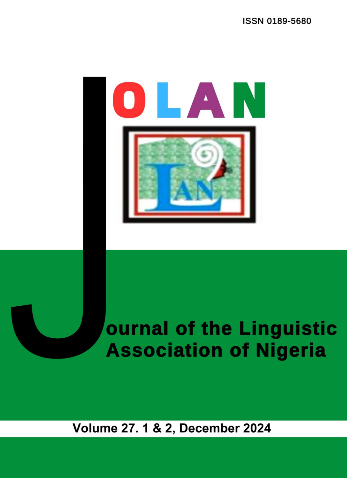Syllabic and Tonal Patterns of Esan Serial Verb Constructions
Keywords:
Esan, Serial verb construction, syllable pattern, tonal patternAbstract
Contemporary treatments of the serial verb construction provide a broader base for identifying them. In light of these current approaches, this study identifies syllabic and tonal characteristics of symmetrical and asymmetrical types of serial verb constructions in the Esan language. These characteristics are identified on the basis of existing relevant empirical studies of the language. Data for the study were obtained from both primary and secondary sources. Serial verb constructions were extracted from manual recordings of utterances of Esan native speakers domiciled in some speech areas of the language. Data from previous works on Esan serial verb constructions were also examined. Identification of syllabic patterning followed simple existing linguistic practice while while that of tonal patterning was conducted in line with familiar autosegmental tenets. Findings show that these constructs may also be tri-syllabic in Esan and not only bi-syllabic, as claimed in earlier studies. Tonal patterns on some verbs in citation are altered when they co-occur as serial verbs. These changes affect both bi-syllabic and tri-syllabic serial verb constructions in declaratives, imperatives, and the habitual temporal aspect. The study improves on earlier efforts on the study of Esan serial verb constructions and complements identified basis for recognizing this structural type in the language. The study would enhance the documentation of Esan.
References
Aikhenvald, Alexandra & Dixon, William (eds). (2006). Serial Verb Constructions – A Cross Linguistic Typology.(ed.). U. S. A.: Oxford University Press.
Bamgbose, Ayo. (1974). On Serial Verbs and Verb Stems. Journal of West African Languages, 9(1). 17-48.
Bodomo, Adams. 2004. The syntax of nominalized complex verbal predicates in Dagaara. Studia Linguistica. 58 (1). 1-22.
Bodomo, Adams. 2006. On nominalizing the verbal complex in Dagaara and English – 11th Biennial Symposium on Linguistics: Inter Theoretical Approaches of complex verbs constructions. Riec University: Houston Texas. 1-17.
Egbokhare, Francis. 2004. Introduction to Phonetics. Ibadan: Sam Bookman.
Ejele, Philomena. 1982. Towards a phonology of Esan. Unpublished M. A . thesis. London: University College.
Ejele, Philomena 1994. The Semantic Input of Serial Verb Constructions in Communication. Journal of Nigerian Language Studies (NILAS).2. 60-68.
Ejele, Philomena 2003. “Tonal Assimilation in Esan.” Ozo-Mekuri, N. ed. Four decades in the study of languages in Nigeria: A Festschrift for K. Williamson. Aba: National Institute for Nigerian Languages.
Ejele, Philomena. 2004. The Source of the Extra-High Tone in Esan. Journal of the Linguistics Association of Nigeria, 8 (2001-2004). 56-65.
Kambon, Obadele, Osun, Kweku & Amfo, Nana. 2015. A case for revisiting definitions of serial verb constructions- Evidence from Akan serial verb nominalization. Studies in African Linguistics, Vol.44, Number 2.75-99.
Mathews, P. H. 2007. Oxford Concise Dictionary of Linguistics. Oxford: Oxford University Press.
Ndimele, O. M. (1996). On the “kwaness” of the Nigerian Pidgin: Insights from Verb Serialization. Journal of Asian and African Studies, 52, 125-136.
Goldsmith, J.A. 1976, Autosegmental Phonology. Indiana: Indiana University Linguistics Club.
Ikoyo-Eweto, E. O. 2005. Tone and Grammar in Esan. M. A. Thesis. Ibadan: University of Ibadan.
Ikoyo-Eweto, E. O. 2010. A Structural Dialectology of Esan. Ph. D. Thesis. Ibadan: University of Ibadan.
Ikoyo-Eweto, E. O. 2016. Interface of Tone and Tense/Aspect in Esan. Journal of the Linguistic Association of Nigeria. 19, 1.
Pike, Kenneth. 1943. Phonetics. Ann Arbor: University of Michigan Press.
Williamson, Kay. (1965). A grammar of Kolokuma Dialect of Ijo. Cambridge: CUP
Williamson, Kay .1989. The Niger Congo Overview. In J. Bendor Samuel (ed.) The Niger Congo languages. 3-46. Lanham: University of America Press.
Yuka, L. C., (2014). Nominal Serialization in Cameroonian Pidgin. International Journal of Language Studies, 8 (1), 15-32.














